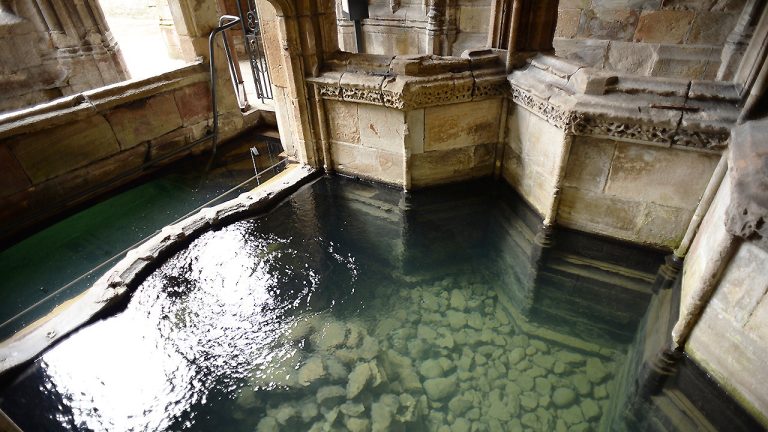Sorry, no records were found. Please adjust your search criteria and try again.
Sorry, unable to load the Maps API.
In my work as a publisher and theologian I’m often dealing with the subject of pilgrimage, but usually as something that other people have done in far-flung places. Personally I’ve always been drawn to the Christian history of our own islands and recently had an opportunity to travel the route of the the St Winefride Pilgrim Trail, which runs from Shrewsbury cathedral to St Winefride’s shrine at Holywell on the north Wales coast, just a few miles from where I live.

Over my 30 years or more in north Wales, St Winefride’s has been a constant place of reference and fascination for me. Of all the inspiring Catholic shrines dotted about the UK, Holywell is uniquely important in being the oldest continuously visited pilgrimage site in Britain. One of the famous Seven Wonders of Wales, it is often referred to by Catholics as the Welsh Lourdes and attracts more than 30,000 visitors every year.
North Wales is a land that’s defined by the spiritual searching of its ancestors – from the great cairns of Barclodaid Y Gawres and Byn Celig Dhu on Anglesey, to the ancient Christian centres of Penmon and Ynys Enlli, the hectic present is ever presided over by the silent watchers of the past.
The pilgrim route from Shrewsbury to Holywell is 70 meandering and undulating miles, and is a seven day walk as it should be experienced if you want to get the deepest understanding of one of the most intriguing of Britain’s Christian saints.
Devout pilgrim souls have been wending their way in search of St Winefride since the 12th century, following in the footsteps of artists, poets, politicians and kings. Richard the Lionheart came in 1189, in 1416 Henry V walked the entire route from Shrewsbury to Holywell to give thanks to St Winefride for his victory at Agincourt. Edward IV visited and took away with him a pinch of earth from beside the well which he had placed in his crown. James II came with his queen to pray for an heir and more recently HRH The Prince of Wales (King Charles III) came in 2021 and knelt to touch the sacred water.

The shrine was almost certainly a critical meeting place for the Gunpowder plotters.
The Catholic poet Gerard Manley Hopkins was captivated by Holywell and the story of St Winefride. Whilst staying at the nearby Jesuit seminary of St Beuno’s in Rhuallt, Hopkins made his first visit on the 8th October 1874 with one of the other new trainee priests, and remembers it thus:
‘Barraud ‘and I walked over to Holywell,’ he wrote in his Journal, ‘and bathed at the well and returned very joyously. The sight of the water in the well as clear as glass, greenish like beryl or aquamarine, trembling at the surface with the force of the springs, and shaping out the five foils of the well, quite drew and held my eyes to it. … even now the stress and buoyancy and abundance of the water is before my eyes.’
The idea of writing a tragedy on the story of St Winefride grew to obsess him for the rest of his life.
We know that St Winefride’s has been a place of pilgrimage since at least 1115, but its roots and healing properties were undoubtedly sought out since the earliest times. The story of the well and shrine begins in the 7th century, when Winefride, the niece of St Beuno was decapitated by a frustrated suitor on hearing the news that she intended to become a nun. It is said the spring at Holywell burst forth from the rocks where her head fell. On hearing the dreadful news, Beuno rushed to Holywell and carried the lifeless Winefride into the church where, after uttering a fervent prayer, she rose up with no sign of the severance of her head except a thin white circle around her neck.
The chapel and shrine that you can visit today dates from the late 15th century. Set into the hillside, it’s a striking and unusual set of buildings, richly decorated and exceptionally well-built. On the bottom floor, the spring water bubbles up into a star-shaped basin beneath an elaborately vaulted ceiling before flowing out into a more recent outdoor pool, where a regular stream of pilgrims still visit to bathe in its clear waters.
St Winefride spent out her days in the safety of the north Wales hamlet of Gwytherin, which itself became a place of pilgrimage for several centuries after her death. In 1138 her relics were removed to Shrewsbury cathedral by Robert of Shrewsbury, the prior, who did much to promote the cult of St Winefride throughout Britain and across Europe.
St Winefride’s elaborate shrine at Shrewsbury was destroyed by Henry VIII in 1540, though a segment of it survives in the abbey to this day, marking the starting point of the St Winefride Pilgrimage Trail.
Remarkably, and for reasons that historians still disagree upon, Winefride’s well and shrine at Holywell escaped the attention of Henry and his Reformation, and also seems to have navigated it way through numerous other attempts to restrict its significance and frustrate the determination of recusant Catholics to visit, pray and seek out cures in its cool, bubbling waters.

Having encountered many points of historical and religious interest along the St Winefride Pilgrimage Trail, the weary pilgrim eventually arrives at their destination – the Shrine and Well of St Winefride in the small market town of Holywell.
St Winefride’s sits in the steep, dappled Greenfield Valley, which is rich in history, from the well itself to the relics and ruins of the Victorian factories that harnessed the well stream to fashion the Industrial Revolution, down to the broad Dee Estuary and the magnificent ruins of mighty Basingwork Abbey where one can sense the whispers of its Cistercian monks who once moved busily through its ancient cloisters and corridors.
Holywell shrine in the late afternoon is a place of notable tranquility and spirituality. Pushed back against an ancient cliff face, embraced by cooling stone walls and shaded by rich vegetation, it seems a million miles way from the nearby A55 expressway relentlessly rushing tourists and lorries to and from the north Wales coast, Holyhead and on to Ireland.

As the sun slides downwards towards evening, the pilgrim numbers start to increase. I kept a discrete distance but felt compelled to watch was all manner of people file into the small, candle heavy chapel to pray and add their own private pleas, before taking the waters. Some bend down unsteadily just to touch the cool flow, whilst others semi-undress and lower themselves down the steps into the outer pool until the water is up to their chest. The more adventurous can then duck down to touch the large flat stone with its red staining that legend says is the blood where Winefride’s head fell.
I saw one or two stalwarts taking the ultimate challenge by submerging themselves totally in the icy water to make their way under the short bridge that separates the inner sanctuary and the outer pool. As I watched in amazement I realised there is a strength of faith in some devout souls that I can only dream of.
Over the centuries there have been literally hundreds of cures for all sorts of ailments witnessed at Holywell, many of them potentially miraculous in nature – though it’s important to point out that curative power of the water at Holywell derives not from any chemical composition but from traversing its unique spiritual environment.
The late afternoon visitors are a mixture of hardy pilgrims, overseas visitors – and many members of the Travelling community for whom Holywell is a compulsory prayer stop on the long journey to and from Holyhead and Ireland. One group were very young people who had attended a wedding earlier in the day, and wanted to leave balloons, mementos of the deceased and prayer requests from family members at the shrine. I spoke briefly to an elderly couple from the Co. Sligo who said they always stopped off each year on the way back home to give thanks for happy reunions and safe journeys. A group of sixth formers and their teacher had just completed the 70 mile walk from Shrewsbury, and were happy to vouch for the beneficial effects of the water on badly aching feet!
These days few arrive on foot, as there are excellent fast train connections from across the UK to nearby Flint railway station, from which the shrine is only a short taxi ride. For those in cars the A55 expressway, which links to the M56, is only minutes away. The charming market town of Holywell itself is just a few minutes walk up the hill from the well, and is well worth a visit. Two of its high street pubs were once recusant meeting houses.
As the sun fades into the folds of Eryri and the final pilgrims head on their weary way, a remarkable silence falls over the shrine at Holywell, broken only by a lone blackbird and the sound of the waters chattering on down the valley, their healing work done. A last few rays of light burst through the leaded windows of the Upper Sanctuary and I’m reminded that for centuries kings and queens have knelt here in the same profound supplication as the humblest and weakest of pilgrims.
Suddenly, I have the sense that my brief dash through ten centuries of Catholic history and devotion has been but one flickering shadow amongst many thousands falling on Holywell’s ancient walls. As I turn for home I leave my summary of Holywell to the far more eloquent pen of Manley Hopkins:
“As long as men are mortal and God merciful So long to this sweet spot, this leafy lean-over, This Dry Dean, now no longer dry nor dumb, but moist and musical With the uproll and the downcarol of day and night delivering Water … Here to this holy well shall pilgrimages be, And not from purple Wales only nor from elmy England, But from beyond seas, Erin, France and Flanders, everywhere, Pilgrims, still pilgrims, more pilgrims, still more poor pilgrims. What sights shall be when some that swung, wretches, on crutches Their crutches shall cast from them, on heels of air departing …’
(St Winefred’s Well Fragment C, ll. 10-14, 18-23)
• Everyone is welcome to join this Sunday’s National Pilgrimage in Thanksgiving to Holywell, led by Rt Rev. Peter Brignall, the Bishop of Wrexham, starting with a procession from the Church of St Winefride in Holywell at 2.30pm and then Mass in the Shrine grounds at 3pm.

For more information: https://www.rcdwxm.org.uk/
Joseph Kelly is a Catholic writer and theologian








































